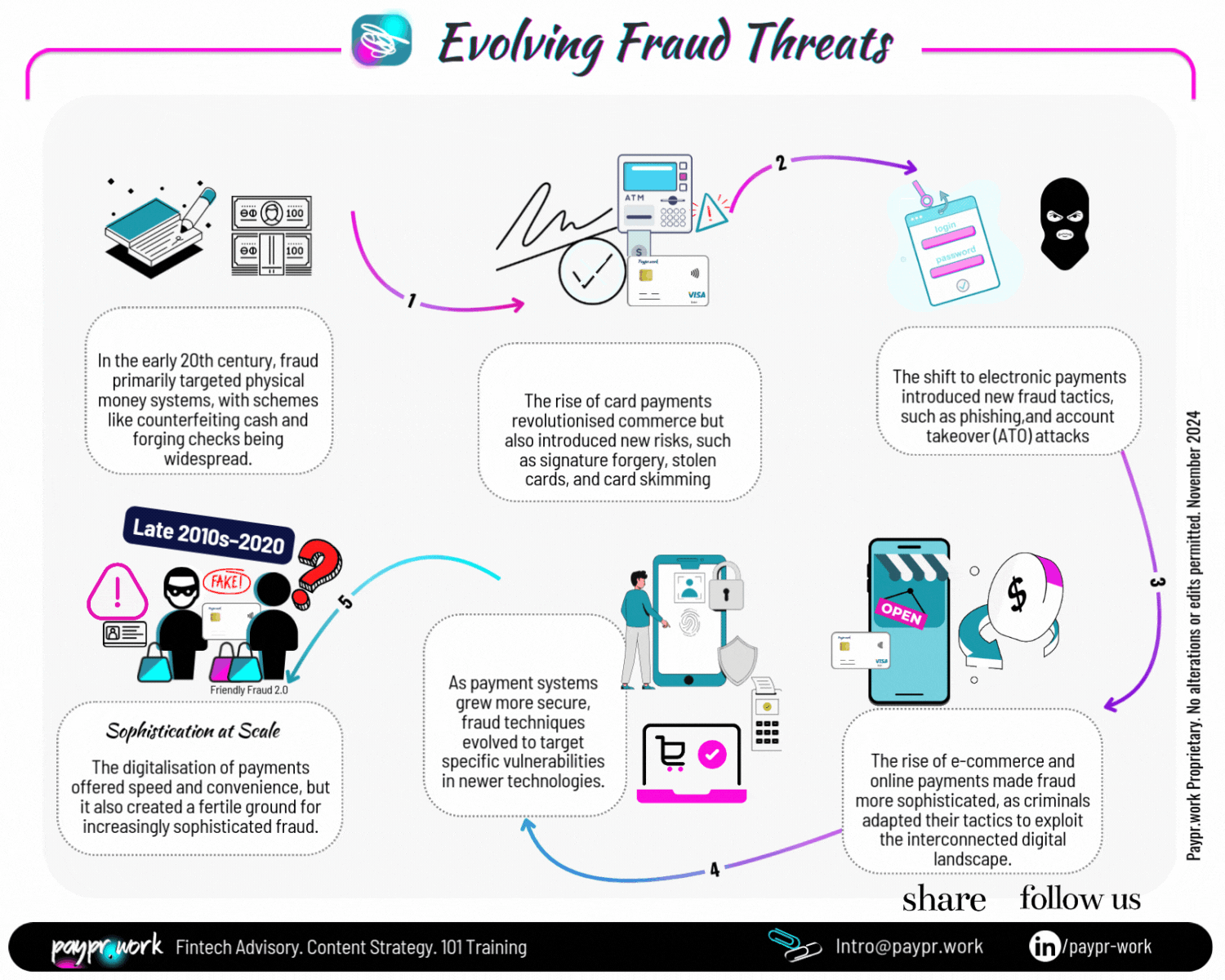
Fraud has always been a persistent challenge, but in recent years, it has transformed from isolated incidents into a full-blown global crisis, posing a significant threat to the trust and security of the payment ecosystem. What began as localised schemes has grown into a sophisticated, globalised issue, exploiting every innovation in payments and commerce. Today, fraud operates on a global scale, exploiting vulnerabilities in digital platforms, payment systems, and regulatory gaps
Ironically, the very advancements that have propelled the financial systems forward, namely technology, globalisation, and complex infrastructures, have also fuelled the evolution of fraud into a sophisticated and pervasive issue. The evolution reflects the increasing complexity and wider challenge posed by these threats.
Fraudsters consistently adapt to exploit every wave of innovation. From counterfeiting to phishing, and now AI-driven fraud and synthetic identities, their methods grow more advanced with each passing year. According to Ravelin Technology’s 2024 Fraud Report, 57% of businesses reported a rise in fraud attempts over the past year, with machine learning and synthetic identities becoming major tools in fraudsters’ arsenals.
Merchant Fraud Risks Vary Significantly
Merchant fraud risks can vary widely depending on factors such as industry, transaction channels, customer demographics, and geographic location. For instance, e-commerce businesses often face high rates of card-not-present (CNP) fraud, accounting for nearly 85% of all payment fraud losses in 2023. Meanwhile, brick-and-mortar retailers might grapple with return fraud or theft of gift card balances, which reportedly costs the retail industry over $24 billion annually.
Tailored fraud prevention strategies are critical to addressing these unique risks. A one-size-fits-all approach often fails to account for specific patterns, such as unusual transaction behaviors, regional fraud trends, or emerging attack vectors like synthetic identity fraud—estimated to cost the U.S. economy $4.5 billion annually. Similarly, businesses with recurring revenue models face higher risks from account takeover (ATO) attacks, which surged by 67% in 2023, as fraudsters exploited weak credential security and automation tools.
Effective prevention requires:
Without this alignment, businesses risk relying on generic solutions that may miss subtle, targeted threats. For example, a fraud tool optimized for retail transactions might not effectively mitigate the risks faced by subscription services or cross-border payment platforms. The result? Higher operational costs, damaged customer trust, and increased fraud losses, which reached a staggering $41 billion globally in 2023.
The Sophistication of Fraud, How did we get Here…
The roots of fraud lie in the earliest financial systems, where physical currency and paper-based transactions dominated commerce.
Though primitive by modern standards, these early fraud techniques laid the groundwork for more elaborate schemes in the future.
Mid-20th Century: The Birth of Card-Based Fraud
The advent of payment cards revolutionised commerce, but they also introduced new vulnerabilities for exploitation.
As the payment ecosystem expanded, fraudsters adapted, finding new ways to exploit these innovations.
Late 20th Century: The Digital Transition
The digital revolution brought a new wave of payment systems—and fraud techniques.
The digitalisation of payments offered speed and convenience, but it also created a fertile ground for increasingly sophisticated fraud.
Early 21st Century: The Internet Era
With the explosion of e-commerce and online payments, fraud became more dynamic, adapting to the connected world.
The internet era democratised commerce, but it also allowed fraudsters to operate on an unprecedented scale.
Mid-2010s: Emerging Complexities
As payment systems grew more secure, fraud techniques evolved to target specific vulnerabilities in newer technologies.
These new methods underscored the adaptability of fraud in response to technological progress.
Late 2010s–2020s: Sophistication at Scale
The digital payments landscape became more advanced—and so did fraud.
In this era, fraudsters began leveraging the same tools—AI, machine learning, and automation—that financial institutions use to prevent them.
The evolution of fraud reflects its adaptability and persistence. As payment systems become more advanced, fraudsters innovate, finding new ways to exploit vulnerabilities. For the payment industry, this ongoing arms race underscores the need for vigilance, collaboration, and investment in cutting-edge technologies to stay ahead.
Combating fraud is not just about reacting to new threats—it’s about building systems that anticipate and prevent them. By placing trust and security at the core of the payment ecosystem, the industry can continue to foster innovation while safeguarding the integrity of global commerce.

Paypr.work blends payment knowledge and custom research into a simplified yet insightful narration. Our narratives feature visually engaging designs that break down both fundamental and complex payment jargons into bite-sized, repetitive micro-concepts to promote better comprehension and retention.
Sign up for a Paypr.work Premium Membership to exclusively access all of our payment resources, including our full articles, industry insights, ecosystem maps, reports, videos, and our unique library of bespoke infographics.
Don’t miss out— sign up to learn payments in a captivating way!



You have provided so much light and knowledge in a fascinating world. You definitely bring the fun to Fintech like no one else and actually know what you are talking about! Thanks goodness for you😁!

Vice President Global Product Expansion, Shift4
Impressive, congratulations Sandra and Team Paypr.work. The detail in each of your 100+ infographics is outstanding and showcases your expertise well… Continued success for this remarkable work!

LinkedIn Strategist | Digital Transformation Leader

Host of Heads Talk
Your diagrams have the ability to explain the most complicated of topics in way that can be understood by anyone. Not many people have the ability to create self-explanatory visuals, so keep doing your magic 🔥🔥🔥!

CEO & Co Founder of CLOWD9
Your content is so informative, accurate, and fabulously presented in infographics that always attract great attention. Your visuals naturally spark strong engagement regardless of the LinkedIn algorithms !

B2B Marketing, Marqeta
The depth of Paypr.work knowledge and skill sets are truly impressive. Their ability to combine deep industry expertise with well-depicted visual is pretty unique. I strongly recommend Sandra and Paypr.work !

Director EMEA Payment Solutions, Marriott International
👏👏 👏👏 👏👏 I always love your content and in fact, I am so happy for all of us in the industry… we’re lucky to have you sharing your payment wisdom with us 🤓… thank you! Keep up the great work.

Strategic Accounts Director, Truelayer | Payments and Fintech Geek
Merci Sandra pour ta facilité à vulgariser le paiement via de simples dessins, qui me surprendront toujours. Pour ceux qui ne connaissent pas son travail, je vous invite à suivre Paypr.work [ˈpeɪpəwəːk]!

Product Manager Paiement, Maisons du Monde
Your enthusiasm and ability to simplify Payments is so refreshing and literally shines through! Sandra and her team research, write content and create some stunning infographics for the payments industry….

Chief Operations Officer, Clowd9
Keep up the good work and know that your hard work and dedication is so inspiring for all of us. You are truly doing an incredible job and your consistent efforts don’t go unnoticed.

Chief Community Officer, NORBr | Redefining Payment Infrastructure | Linkedin Top Voice
Your posts are a masterclass in how payments have evolved from a basic utility to a strategic asset. Your ability to simplify this complexity and provide strategic direction along with implementation support is so invaluable. The clarity and depth you provide are exactly what this fast-evolving industry needs.

Chief Commercial and Operations Officer, Soffid
The mechanics of all things payment are a black box for most industry stakeholders. With the help of their well researched and designed infographics, Sandra and her team at Papr.work demystify complex flows and create awareness about the factors that play a role in the end to end processes.

Paul van Alfen | Managing Director Managing, Up in the Air - Travel Payment Consultancy
Your Paypr.work subscription gets you full access to all Paypr.work content in 1 place including: our weekly new payments articles, our infographic blog, exclusive discounts on all the services that Paypr.work has to offer and the opportunity to collaborate on free infographic to promote your knowledge/value proposition and more. The content is for personal use and cannot be copied, reproduced, redistributed, altered, modified, shared publicly or with third-party nor can derivatives of the work be created. The user may share content that is available through the free blog access subject to crediting Paypr.work with the attributions.